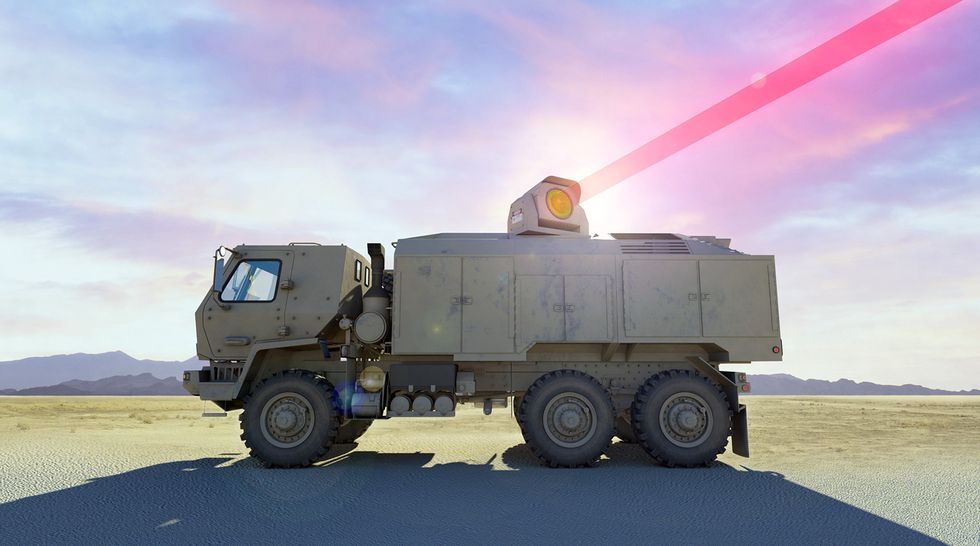
“The U.S. Army wants to develop a new laser weapon that is more powerful than existing weapons by nearly three orders of magnitude, but lasts just a fraction as long.
The service posted a notice for the prospective new weapon at the Pentagon’s Small Business Investment Research website, calling the weapon the Tactical Ultrashort Pulsed Laser for Army Platforms. The Army believes it can merely aim the laser at a drone to both damage it and fry its electronic guts.
Most military lasers are continuous wave lasers, or those that blast a target with a continuous beam of energy. Continuous wave lasers need that blast because they effectively work like blowtorches, heating the surface of a target—say, a flying drone—until a part melts off, inducing aerodynamic failure and a crash, or the fuel or explosive payload explodes.
The problem? Sometimes continuous wave lasers, often in the kilowatt class, need to focus on a single point on a target for a few seconds to work properly.
Ultrashort Pulse Lasers, however, would trade duration for power, firing a 1-terawatt, 200-femtosecond-long burst of laser energy. For context, 1 terawatt is 1 trillion watts, while 1 femtosecond is the equivalent of 1 quadrillionth of a second.” PM
Comment: This baby will burn the feathers off any drones silly enough to come within range of a ground force so equipped. A companion piece in PM says that USAF want to put similar lasers on fighter aircraft. pl

Can the US still make weapons, or does it just make cost over-runs?
The problem with high power lasers is that anything in the path can absorb or deflect the beam. Fog, dust, haze, even the air itself, can heat and disperse the beam. The power supplies and batteries to power them are themselves a massive engineering challenge as well. Not going happen. I say this having designed high power lasers myself…
The idea sounds interesting, but doubtless technical issues will need to be surmounted.
Let’s see what is going on in Defense Acquisitions World:
https://www.forbes.com/sites/davidaxe/2021/02/23/the-us-air-force-just-admitted-the-f-35-stealth-fighter-has-failed/?sh=1218b7551b16
Hello, there. Aargh.
Fat times are over, folks.
And by the way, pResident Joe authorized strikes against Shia militias in the Middle East. And they’re off…
If I read this correctly, a “Ultrashort Pulse Lasers” acts like a bullet, albeit one that isn’t affected by gravity and doesn’t require any deflection-shooting.
Fabulous. I can see the advantage.
Only…. I can also see the downside. The M61 Vulcan gatling gun fires its gravity-affected and deflection-calculated 20mm slugs at the rate of 6,000 rounds a minute, so it can afford to hose its target until it achieves a kill.
What about the Ultrashort Pulse Laser?
If the calculated firing-solution is slightly off center then that 200-femtosecond-long burst will miss, at which point I’d be curious to know how long before it can charge up again to take another shot.
Even if it is 5 seconds or so (no idea, to be honest) then the laser will require a complete recalculation of its firing solution, not just a minute adjustment based on the last “fall of shot”.
It could result in a situation where the laser pulse is fabulously destructive…. if it hits. But if the operator misses on their first shot then whatever they were aiming at is long gone before the laser is ready to fire its second shot.
No one would believe the US if it said it would field a short range air defence system like the Russian Pantsir system within 5-10 years. So lasers. Has the US developed the ability to detect and target multiple drones and missiles at short range in a land based combat environment? Well, no, but lasers.
Apart from turning AAM and MANPADs into SAMs the US in particular really isn’t in the SHORADS game as a ground up system, just individual elements. So, as you say, no Pantsir equivalent on the horizon which means no IADS either.
I suppose what they could be doing is basing it on a Vulcan gun systems, changing the Gatling gun element into a laser ‘gun’. A standalone system. Or, to maximise R&D profits doing it from scratch (or saying they are for megga profits) to help the political contribution fund.
Probably very good on a ship, which arguably needs it most, with its space, power supply and radars, OK Vulcan based on a truck, but really tough on an aircraft (no space, no power, new aiming system).